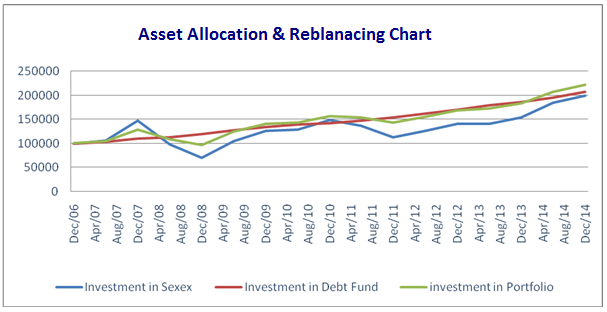- February 28, 2015
- by Prakash Lohana
- Articles
- 252 Views
- 0 Comments
In may last article on Asset Allocation, I had discussed how Asset Allocation and Rebalancing of portfolio is done at periodic frequency.Now in this article I have given a back testing of the same for a period of 31/12/2006 to 31/12/2014. Let us see below, how Asset allocation and rebalancing actually works and help investors to reduce risk in their portfolio and make reasonable returns.
In below calculation I have taken an investment of Rs. 1 lac and divided it in 50% to Sensex (Equity) and 50% to Franklin India Short Term Bond Fund ( Debt) and thereafter rebalanced on a half yearly basis. Figures of the Sensex and NAV of Fund are real.

Rebalancing of Portfolio : In above table, you can see that every six months I have made both equity and Debt equal (50%:50%) and for that I have done rebalancing of portfolio, in real life we try to rebalance the portfolio by putting fresh money in the asset class which has fallen and bring it to the percentage allocation that is required initially and if we cannot meet the required percentage of allocation by putting fresh money then only we rebalance the portfolio and sell the asset class which is above required allocation and invest in asset class which is below the required allocation.


Above table clearly proves that Rs. 1 lack invested in Sensex (Equity) has given a compounded annualized return of around 9.01% p.a. whereas Rs. 1 lack invested in Franklin India Short Term income Plan (Debt) has given 9.53% p.a. compounded annualized returns and money invested in 50 : 50 allocation and rebalanced on half yearly basis has given around 10.43% compounded annualized returns which is higher than both asset classes in which actually investment is done. You can also observe in above chart that money invested in equity had highest volatility and money invested in Bond fund had very low volatility whereas money invested in both in equal proportion and rebalanced has moderate volatility but higher returns. So asset allocation offers higher returns at lower risk.
Benefits of Asset Allocation:
Risk Management: By rebalancing or investing fresh money in asset class which has fallen, you will be investing in asset class which has not done good in recent past and is available at cheaper rate and vice versa. In above table you can observe that in Dec-2007 when Sensex had gone up sharply from 14650 to 20286. Money was taken out from Sensex (Equity) and was invested in Bond Fund. Where as in Dec-2008 when Sensex had fallen to 9647 levels money was invested to Sensex (Equity) . This helps you to invest in asset class which is cheaper and keeps you away from asset class which is overvalued so the risk of investing in equity or any other asset class at the time when it is overvalued is taken care and that is why I always say that Asset allocation is a most effective method of risk management.
Buy at Low and Sell at High: Normally investors always want to buy when markets are low and sell when markets are high. But normally most of the investors fail in doing this because they are always confused about whether markets are high or low right now and whether they should buy or sell right now. But Asset allocation is a mathematical model which resolves this confusion and helps us to buy at low and sell at high.
 Keeps you away from Market Timing:
Keeps you away from Market Timing:
Market timing is an activity by which you try to predict the future movement of market and believe that you can catch bottom of the market and sell at peak of the market. This appears very simple but it is actually impossible. A research by landmark Brinson, Hood and Beebower, “Determinants of Portfolio Performance” (1986, 1991) argues that Asset Allocation accounts for 94% of the variation in returns in a portfolio, leaving market timing and stock selection to account for only 6%.
Conclusion: Asset allocation seems a very simple method so most of the investors don’t understand its importance. But I would recommend that asset allocation is the Back bone of your portfolio and you should adopt it without any doubt.

